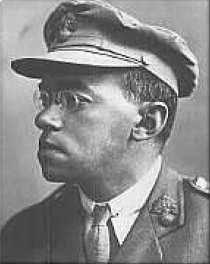User:Bane117/Revisionist Maximalism
Revisionist Maximalism was a right-wing militant political ideology founded by Abba Ahimeir during the 1930s and ended in 1937. Revisionist Maximalism was a Jewish ideology that borrowed principles from totalitarianism, and inspiration from Pilsudski's Poland, Mussolini's Italy, and the Irish struggle against Britain. [1]
History
[edit]The Revisionist Maximalism movement was created during the 1930s as a way to strengthen Jewish nationalism, and to give cultural, political, and social stability. [2] Abba Ahimier was born in Russia in 1897 and migrated to Palestine at the age of fifteen. After the end of WW1, Ahimier entered the University of Kiev in Russia , then traveled to Liege and Vienna to complete his academic studies. He then returned to Palestine and became close in contact with other socialist circles, and organizations. In 1928 Ahimier joined Jabotinsky's Revisionist movement and became one of the movement's important activists. [3]


During the 1930's the members of the Revisionist Maximalism movement saw themselves as warriors, leaders, and pioneers, fighting for the establishment for a Jewish state. Members of the movement were encouraged to learn boxing, fencing, sharpshooting, and jiujutsu in order to defend themselves, and create a stronger militaristic presence.[4] Ze'ev Jobotisky, who was born in 1880 to a middle-class family in Odessa Russia, was one of the founders and important figures during the Revisionist movement. [5] He and his followers of the Revisionist movement organized a Jewish defense force in order to fight against Arab attacks on the Jewish population in Palestine. Soon in 1920, British authorities jailed Jobotisky and sentenced him 15 years for establishing a Jewish defense force. Jobotisky was later released on the summer of 1920 after local Jewish communities protested for his release.
[6] In 1931 Jobotinsky, and members of the Revisionist movement launched an attack on the 17th Congress, in order to force Chaim Weizman to resign as president of the World Zionist Organization. Jobotisky along with the other Revisionist Zionists, wanted to obtain all of Eretz Yisrael, (Land of Israel) and establish a Jewish state, and did not settle for a two state solution in Palestine.[7] Soon, Abba Ahimier the poet Uri Zvi Gruenberg, and Wolfgang von Weisl, the chairman of their Palestine central committee, became the ideological leaders of the Revisionist, after Jobotisky was banned from returning to Palestine by the British authorities, due to his political activities. During the 1930s, Abba Ahimier Joshua Yevin, and Uri Zvi Grunberg began to establish their own newspapers, and Ha-:Am and Hazit ha- Am, and would publish the idea of "Jewish Labor" and emphasized that Jews should be self- reliant and economically independent [8]. On December 1932 Ahimier alongside with, Weisl, Gruenberg, and his supporters organized a strike-breaking "union" at the Froumine Biscuit Factory in Jerusalem by providing scabs. Then on Febuary 27, 1933, the Maximalist tried to break a building strike in Petah Tikva, where dozens of strikers were arrested for battling the scabs .[9]
Ideology
[edit]The Maximalist Revisionists shared the same characteristics as of the Revisionist Movement, as they both took inspiration from fascist regimes in Pilsudski's Poland, and Mussolini's Italy.[10]However, their goal was to "extract Revisionism from its liberal entrapment", as they wanted Jobotinsky's status to be elevated to a dictator, [11] and desired to force integrate the population of Palestine into Hebrew society. [12] The Maximalists believed that authoritarianism and national solidarity was necessary to have the public collaborate with the government, and to create total unity in Palestine. [13]
References
[edit]- ^ Shlaim, Avi (1996). Shindle, Colin; Shamir, Yitzhak; Arens, Moshe; Begin, Ze‘ev B.; Netanyahu, Benjamin (eds.). "The Likud in Power: The Historiography of Revisionist Zionism". Israel Studies. 1 (2): 279. ISSN 1084-9513.
- ^ TAMIR, DAN (2014). "FROM A FASCIST'S NOTEBOOK TO THE PRINCIPLES OF REBIRTH: THE DESIRE FOR SOCIAL INTEGRATION IN HEBREW FASCISM, 1928–1942". The Historical Journal. 57 (4): 1058–1059. ISSN 0018-246X.
- ^ TAMIR, DAN (2014). "FROM A FASCIST'S NOTEBOOK TO THE PRINCIPLES OF REBIRTH: THE DESIRE FOR SOCIAL INTEGRATION IN HEBREW FASCISM, 1928–1942". The Historical Journal. 57 (4): 1062–1063. ISSN 0018-246X.
- ^ Kaplan, Eran (2005). The Jewish radical right : Revisionist Zionism and its ideological legacy. Madison, Wis.: University of Wisconsin Press. pp. xiii. ISBN 978-0-299-20383-2. OCLC 298789195.
- ^ Kaplan, Eran (2005). The Jewish radical right : Revisionist Zionism and its ideological legacy. Madison, Wis.: University of Wisconsin Press. p. 3. ISBN 978-0-299-20383-2. OCLC 298789195.
- ^ Kaplan, Eran (2005). The Jewish radical right : Revisionist Zionism and its ideological legacy. Madison, Wis.: University of Wisconsin Press. pp. 4–5. ISBN 978-0-299-20383-2. OCLC 298789195.
- ^ Shlaim, Avi (1996). Shindle, Colin; Shamir, Yitzhak; Arens, Moshe; Begin, Ze‘ev B.; Netanyahu, Benjamin (eds.). "The Likud in Power: The Historiography of Revisionist Zionism". Israel Studies. 1 (2): 280–281. ISSN 1084-9513.
- ^ TAMIR, DAN (2014). "FROM A FASCIST'S NOTEBOOK TO THE PRINCIPLES OF REBIRTH: THE DESIRE FOR SOCIAL INTEGRATION IN HEBREW FASCISM, 1928–1942". The Historical Journal. 57 (4): 1061–1072. ISSN 0018-246X.
- ^ Brenner, Lenni (1983). "Zionist-Revisionism: The Years of Fascism and Terror". Journal of Palestine Studies. 13 (1): 72. doi:10.2307/2536926. ISSN 0377-919X.
- ^ Shlaim, Avi (1996). Shindle, Colin; Shamir, Yitzhak; Arens, Moshe; Begin, Ze‘ev B.; Netanyahu, Benjamin (eds.). "The Likud in Power: The Historiography of Revisionist Zionism". Israel Studies. 1 (2): 279. ISSN 1084-9513.
- ^ Naor, Arye (2006). "Review of The Triumph of Military Zionism: Nationalism and the Origins of the Israeli Right". Israel Studies. 11 (3): 176. ISSN 1084-9513.
- ^ TAMIR, DAN (2014). "FROM A FASCIST'S NOTEBOOK TO THE PRINCIPLES OF REBIRTH: THE DESIRE FOR SOCIAL INTEGRATION IN HEBREW FASCISM, 1928–1942". The Historical Journal. 57 (4): 1080. ISSN 0018-246X.
- ^ TAMIR, DAN (2014). "FROM A FASCIST'S NOTEBOOK TO THE PRINCIPLES OF REBIRTH: THE DESIRE FOR SOCIAL INTEGRATION IN HEBREW FASCISM, 1928–1942". The Historical Journal. 57 (4): 1082. ISSN 0018-246X.
